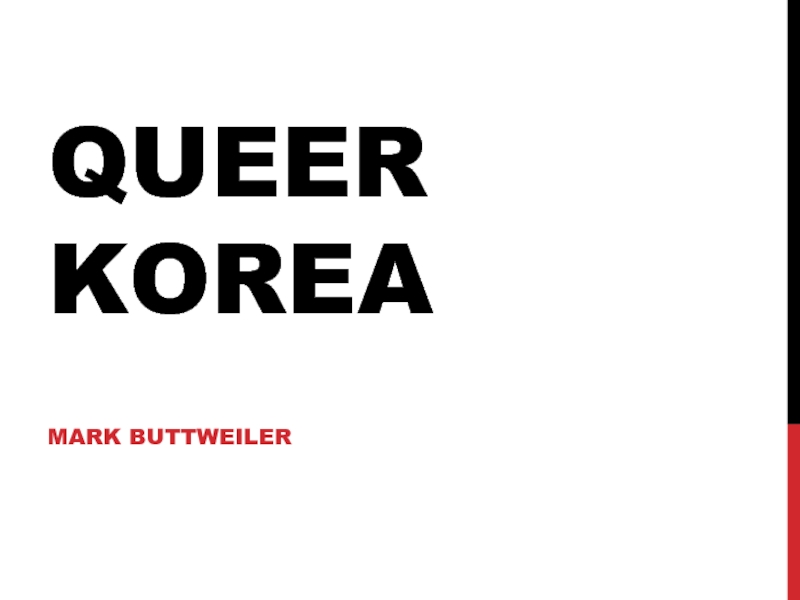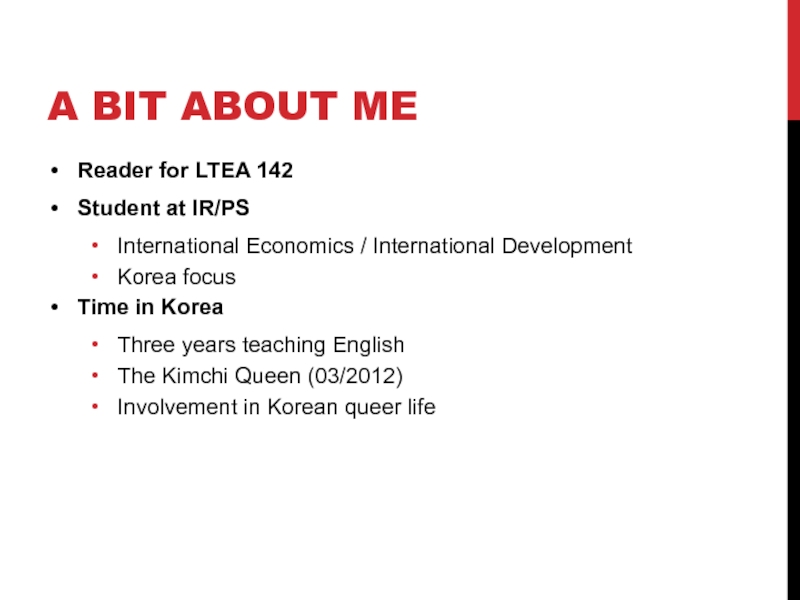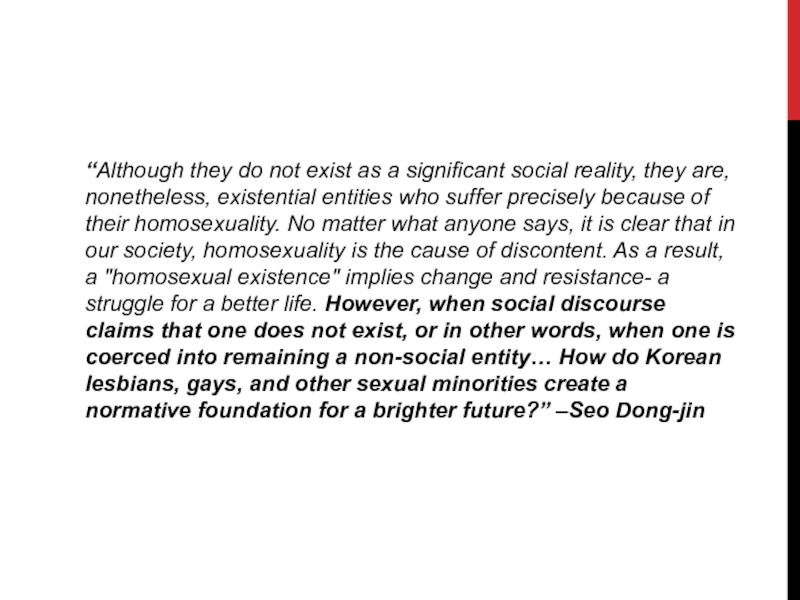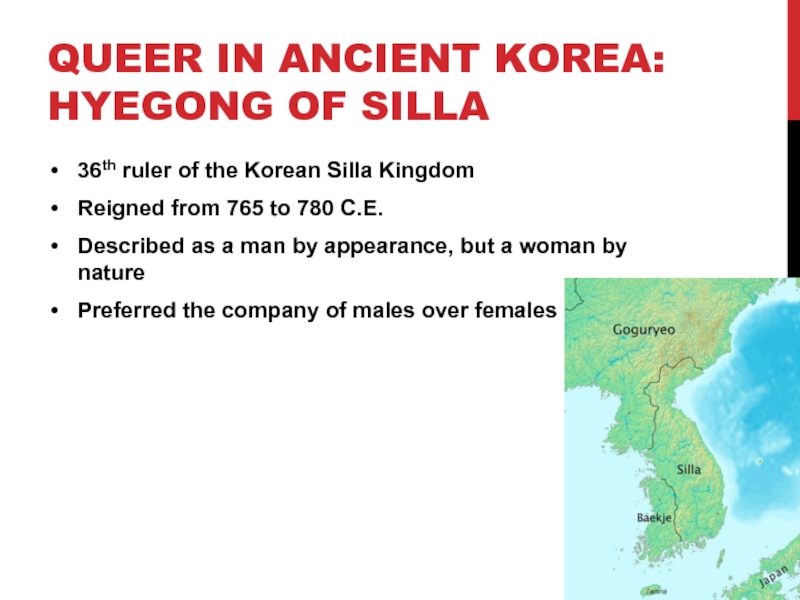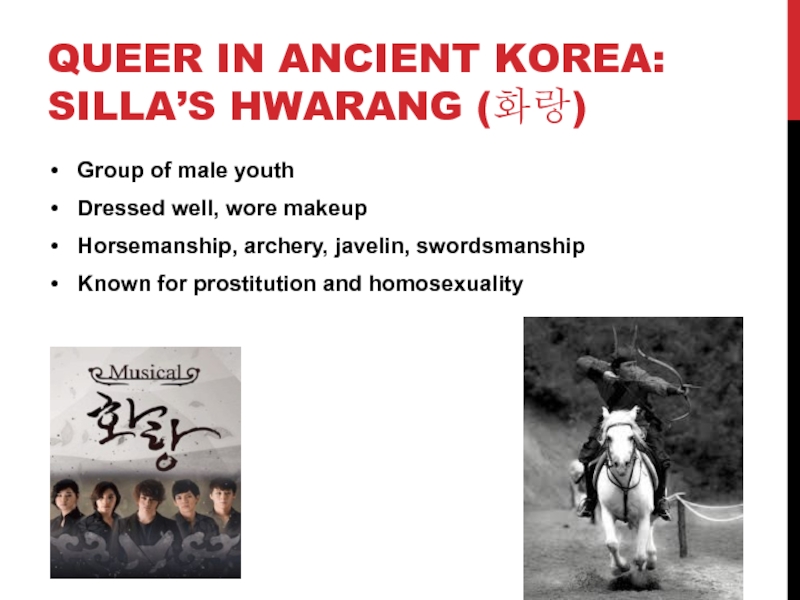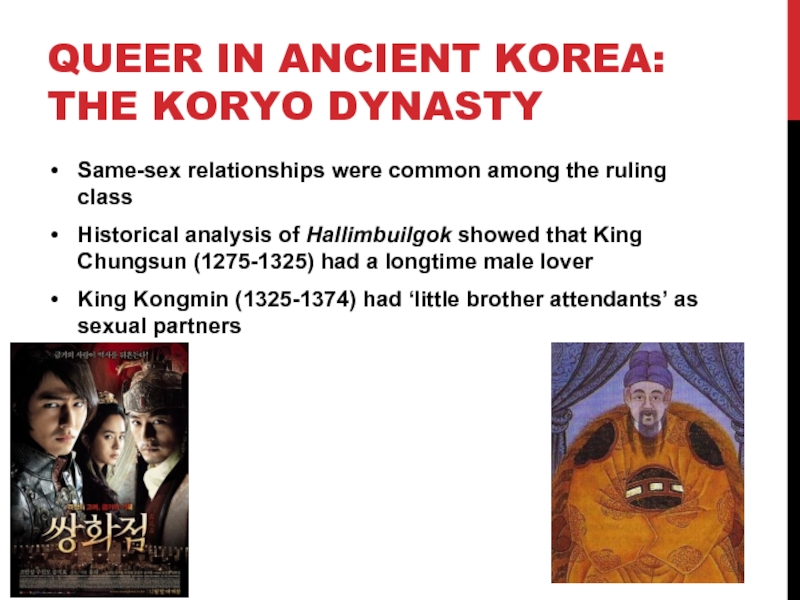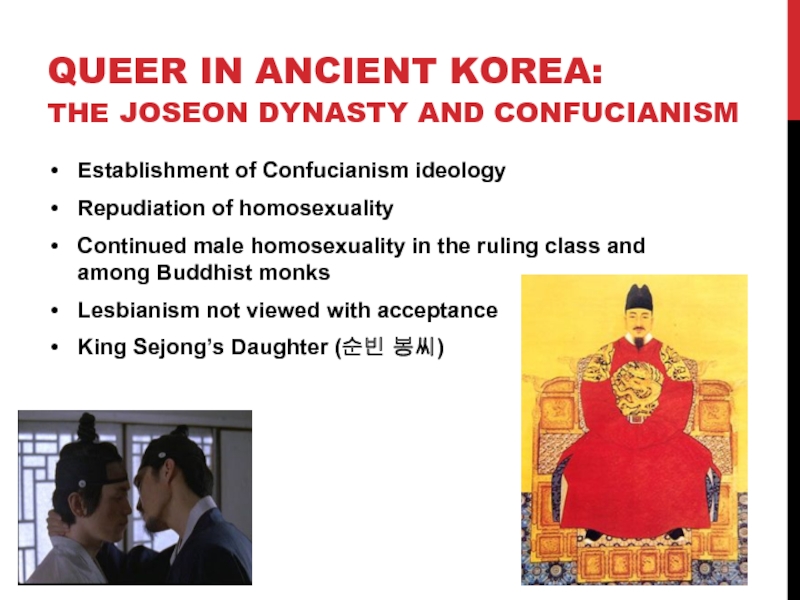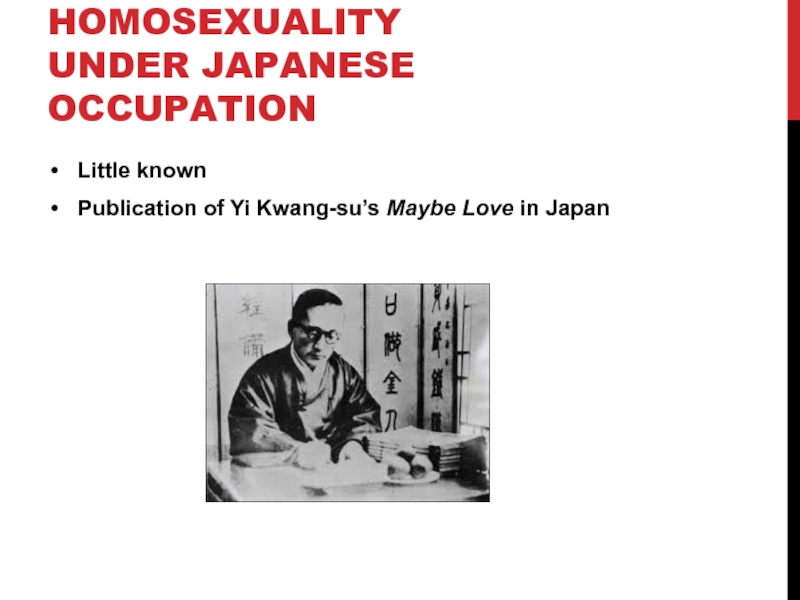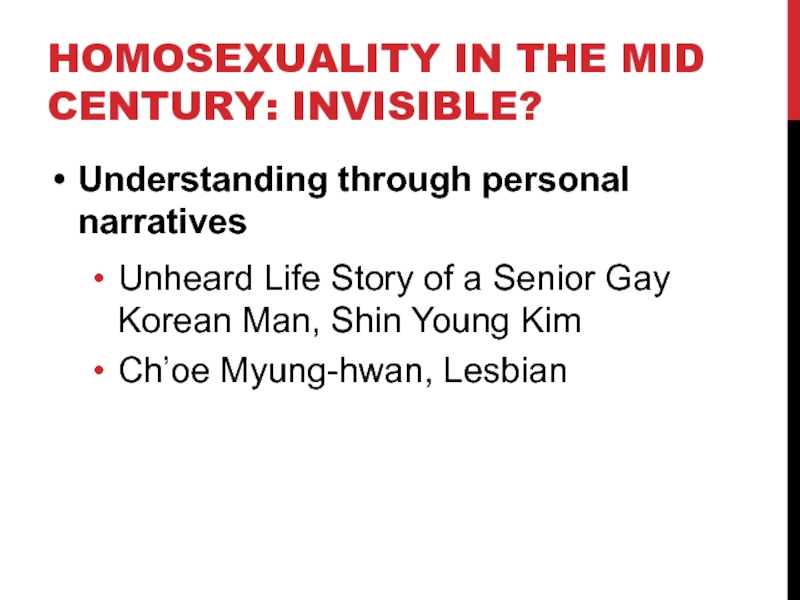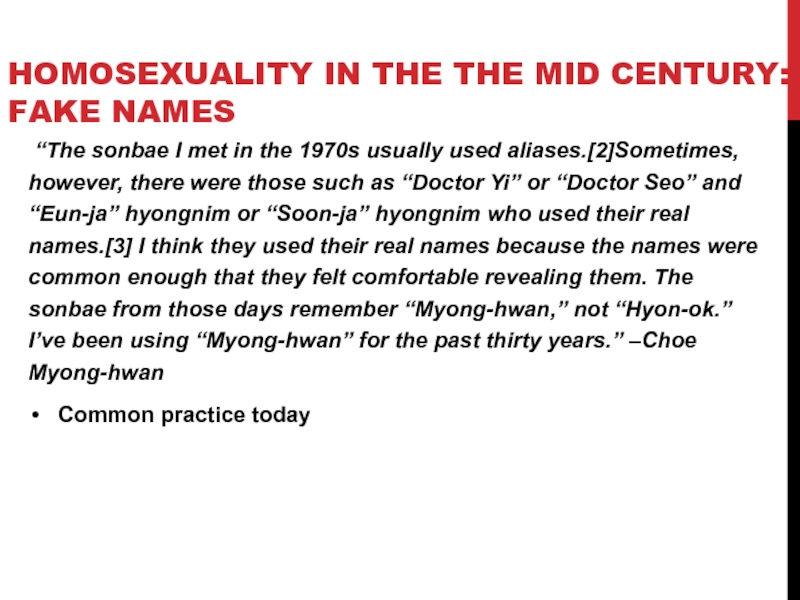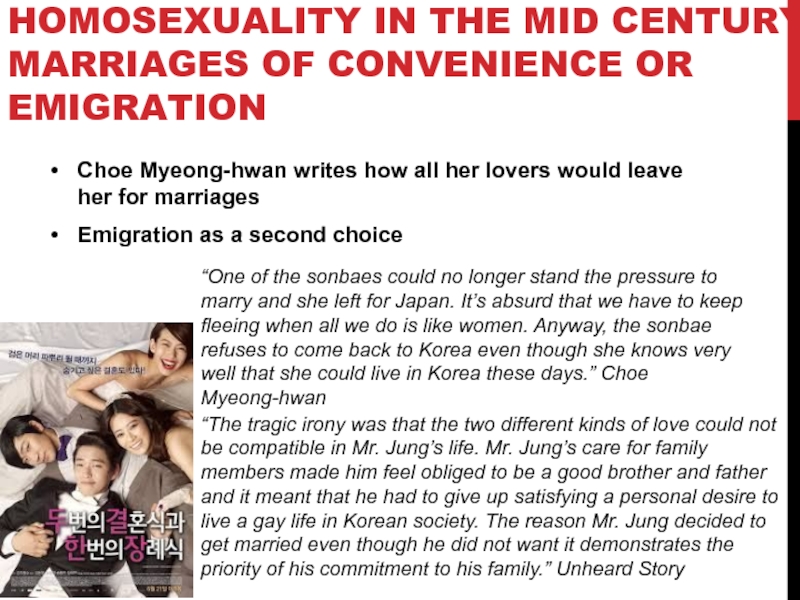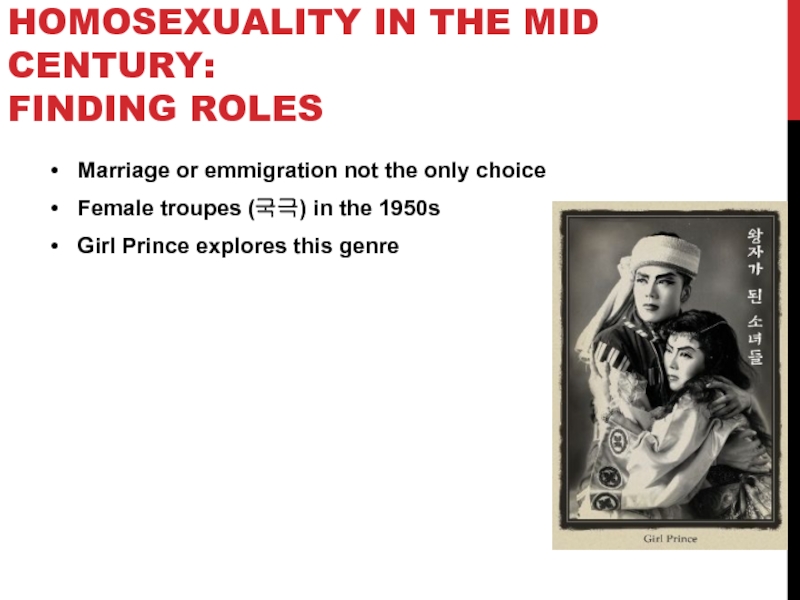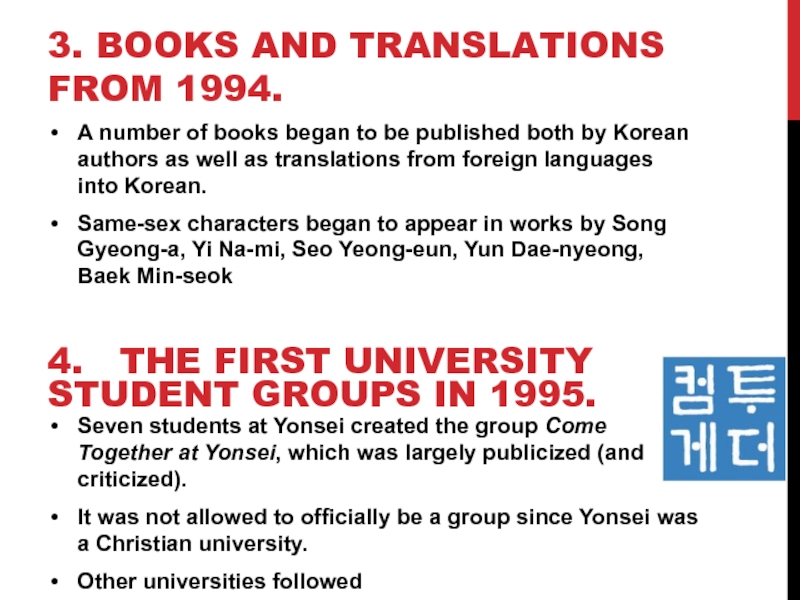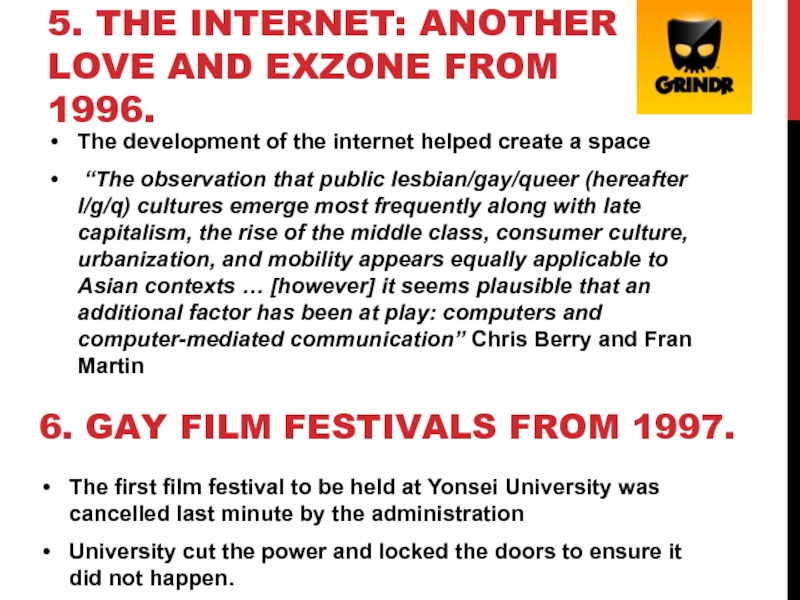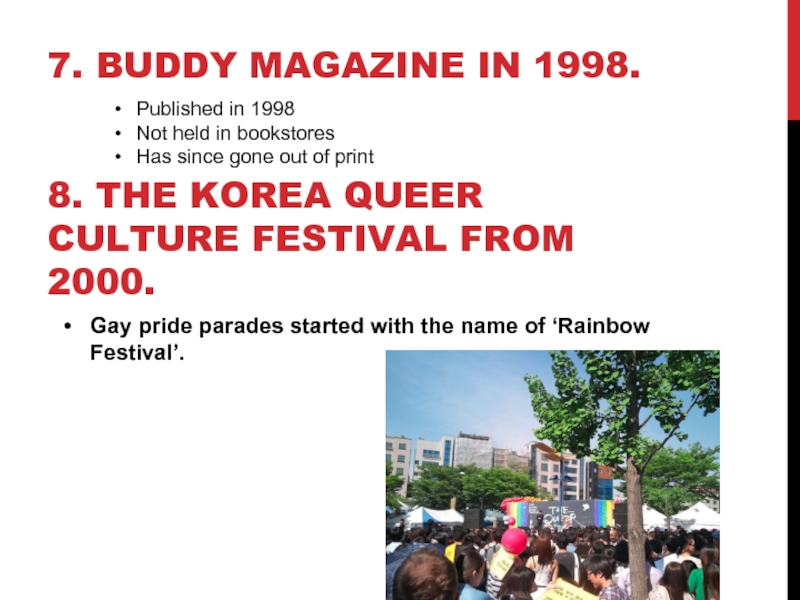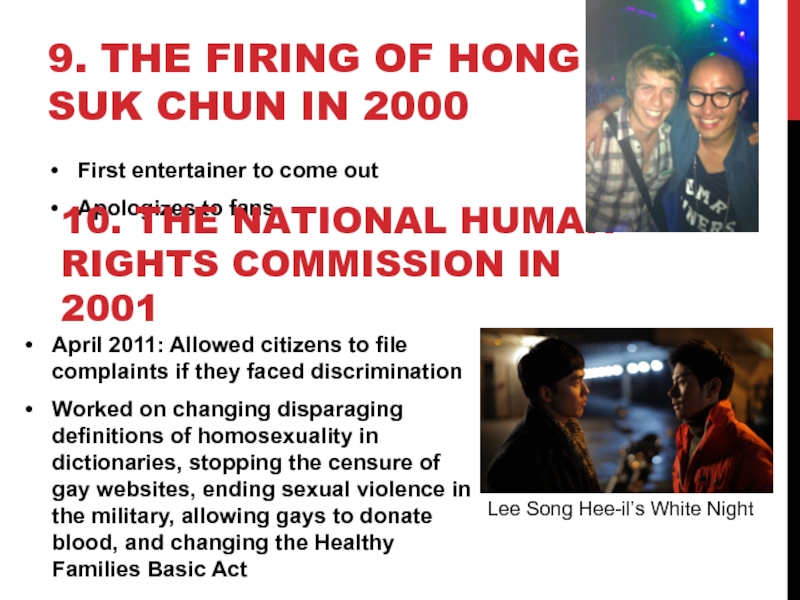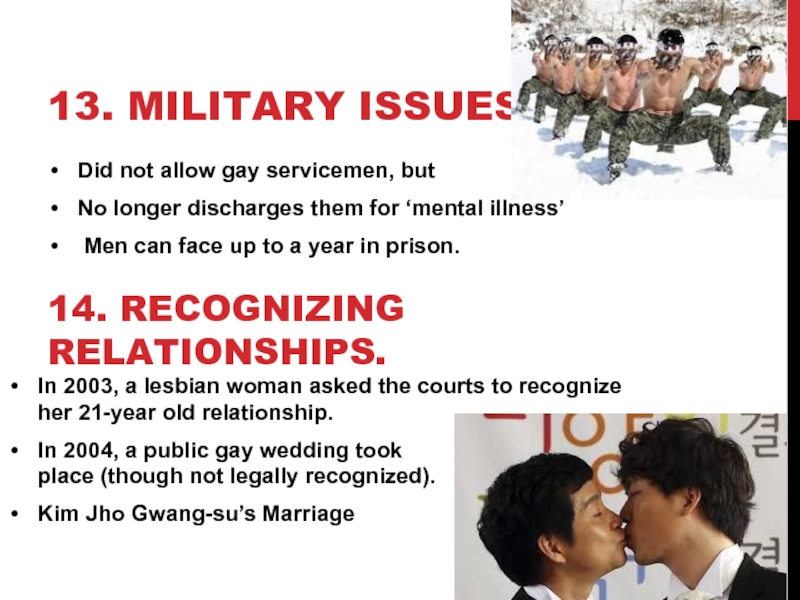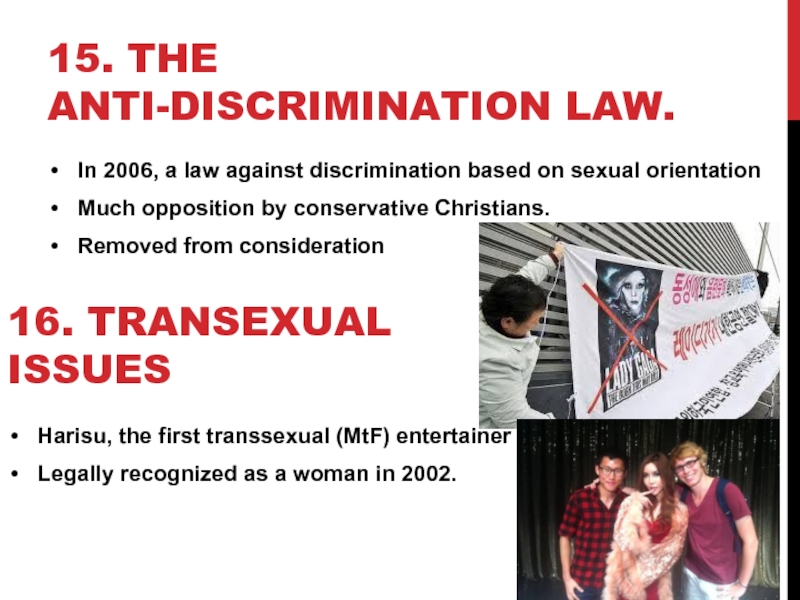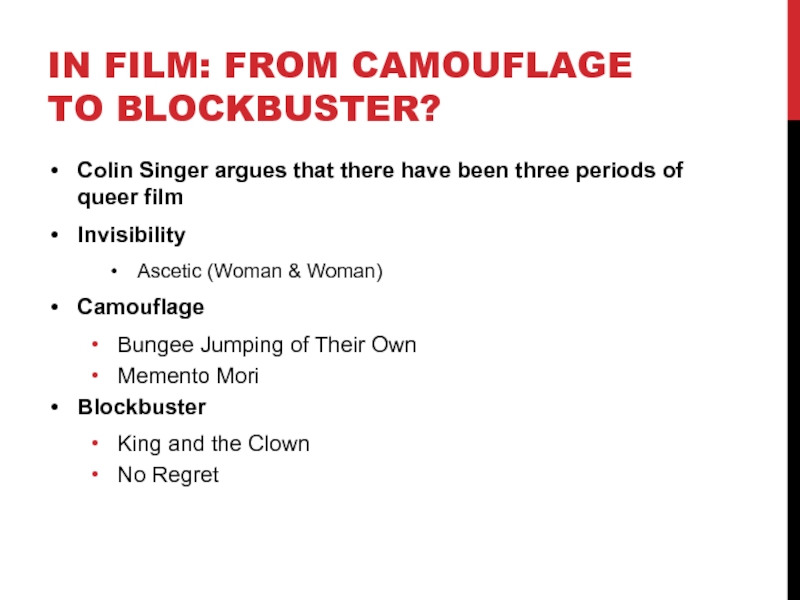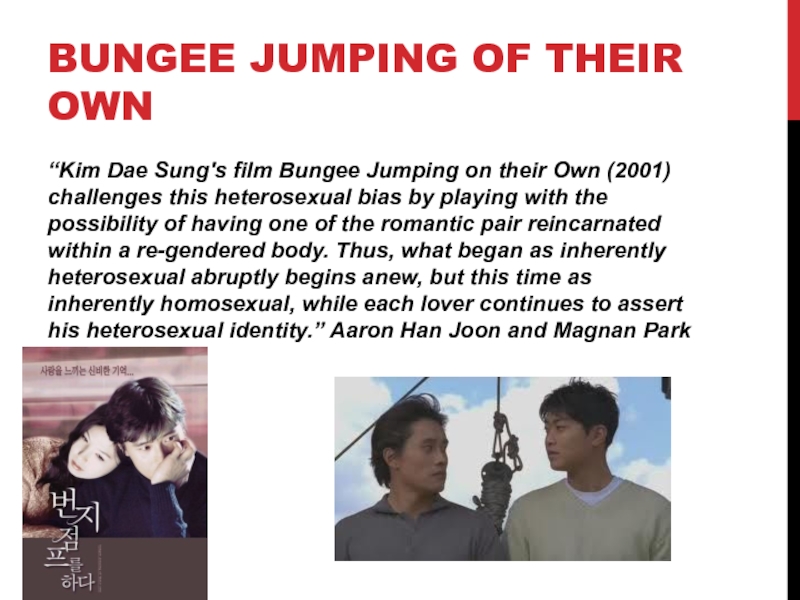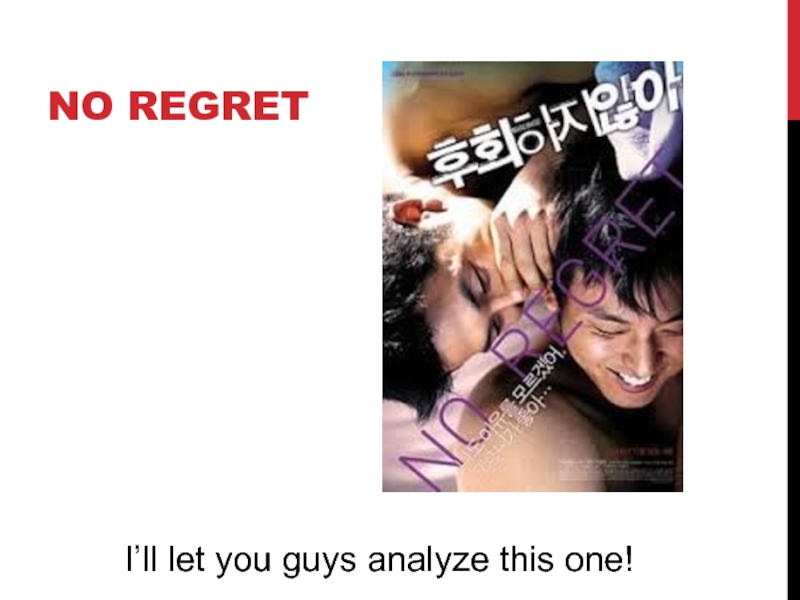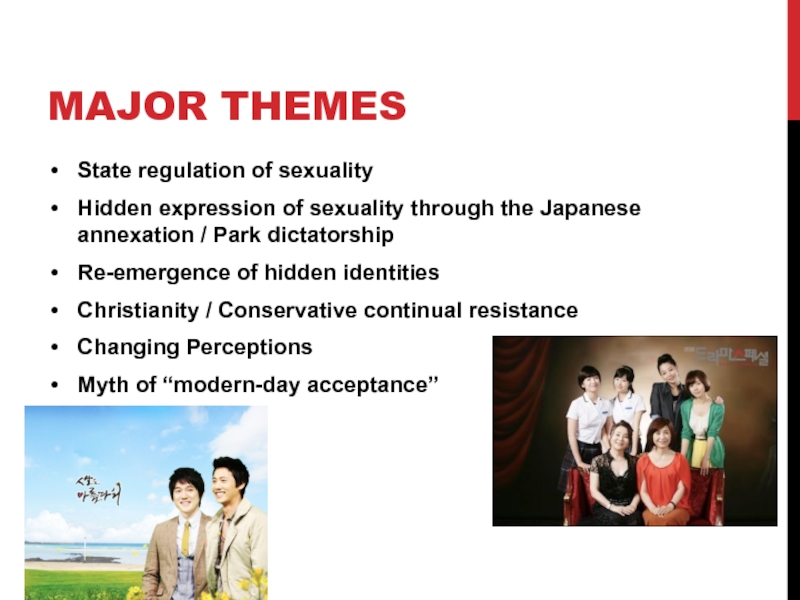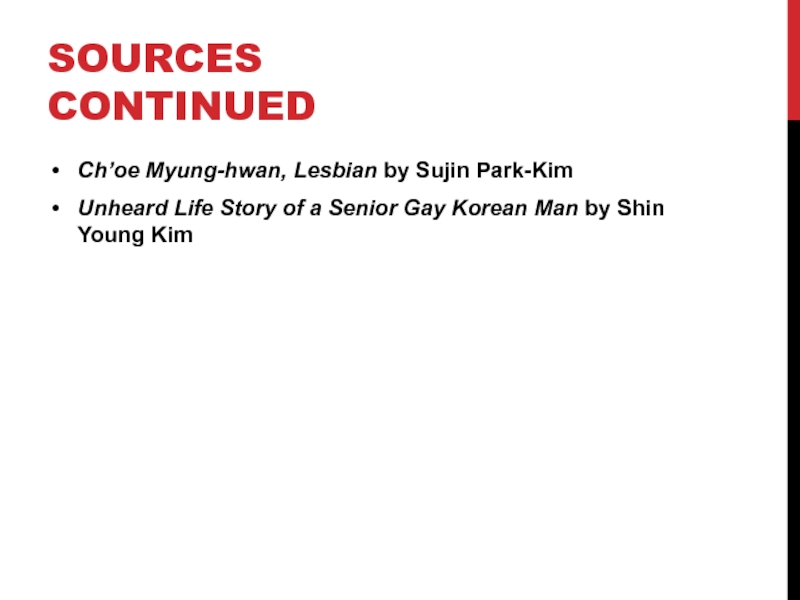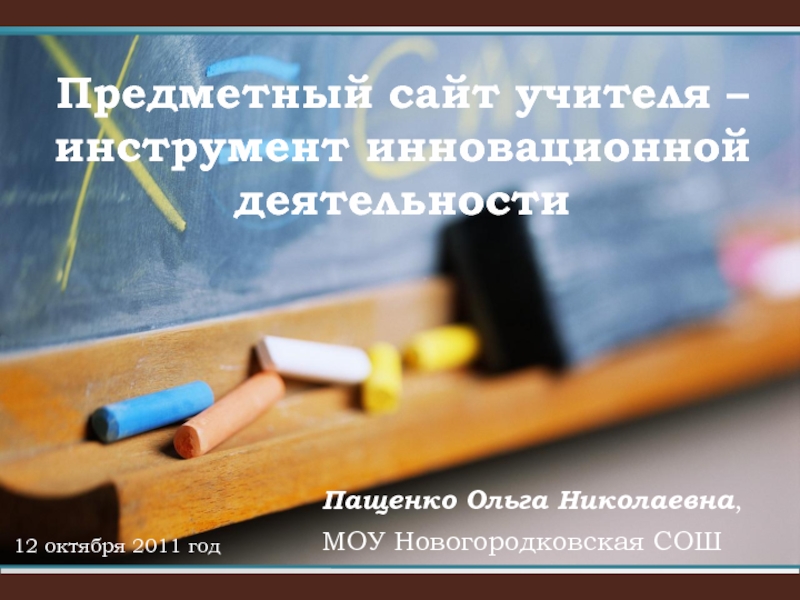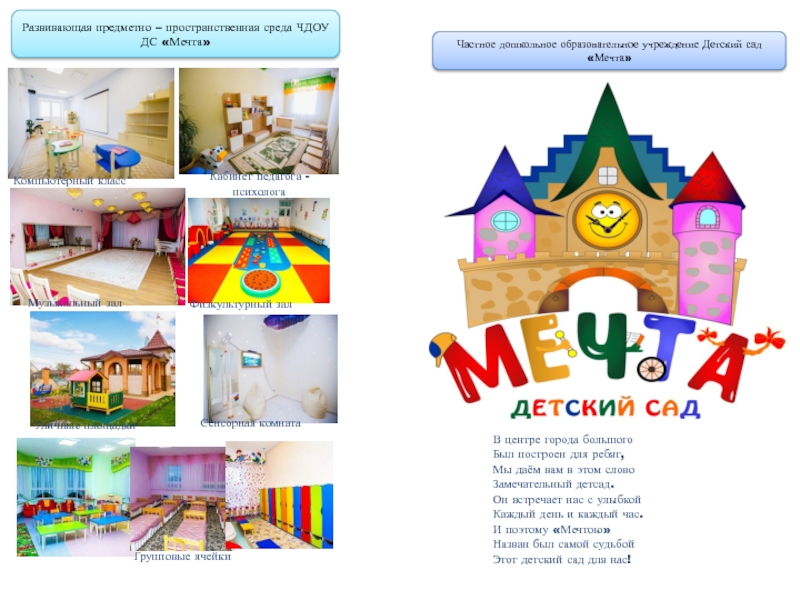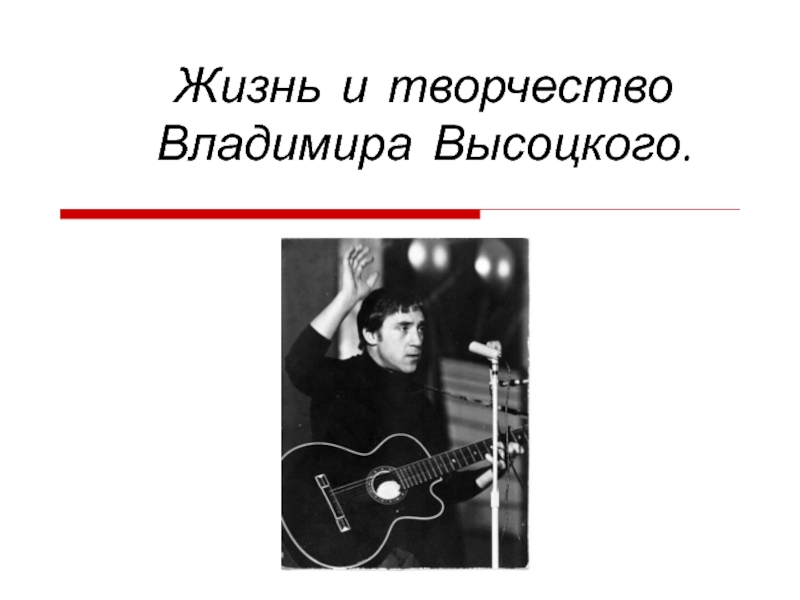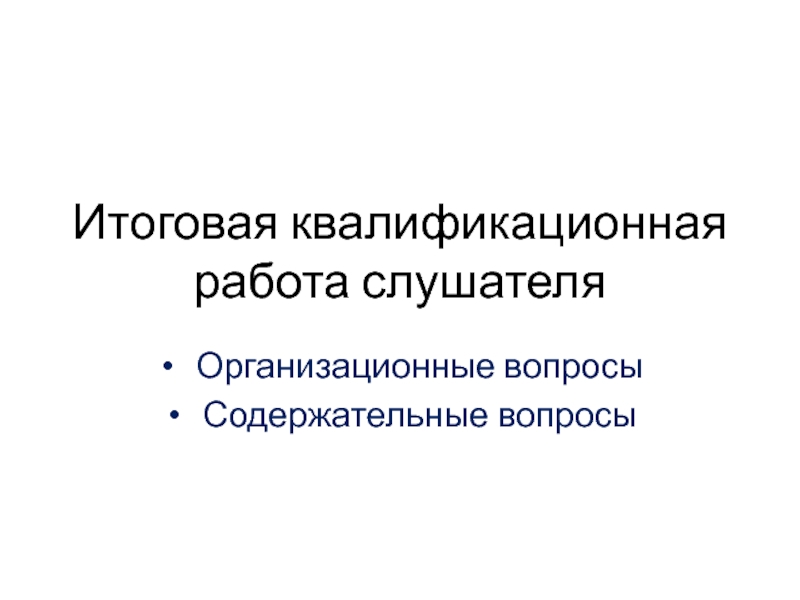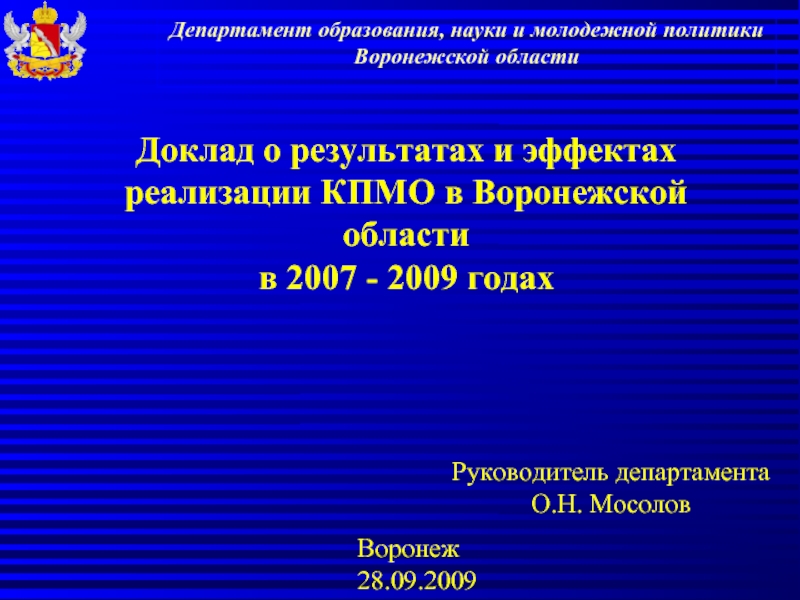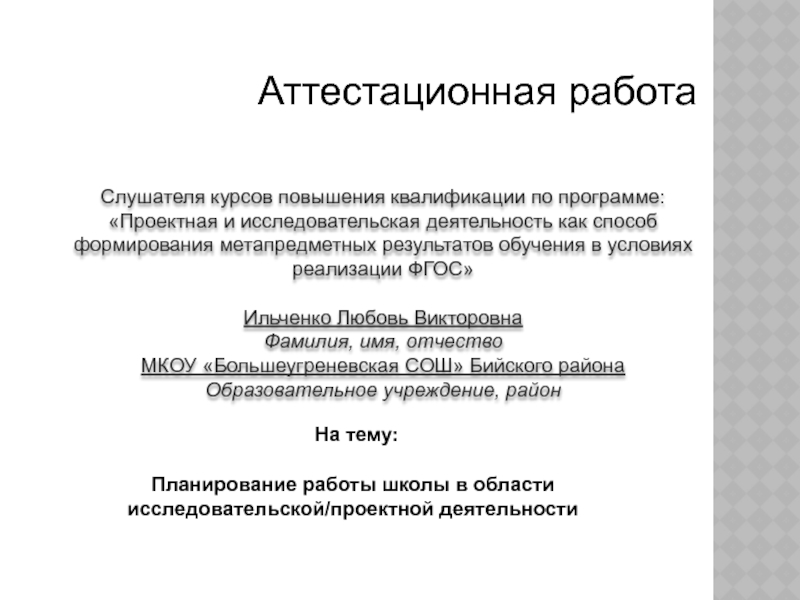- Главная
- Разное
- Дизайн
- Бизнес и предпринимательство
- Аналитика
- Образование
- Развлечения
- Красота и здоровье
- Финансы
- Государство
- Путешествия
- Спорт
- Недвижимость
- Армия
- Графика
- Культурология
- Еда и кулинария
- Лингвистика
- Английский язык
- Астрономия
- Алгебра
- Биология
- География
- Детские презентации
- Информатика
- История
- Литература
- Маркетинг
- Математика
- Медицина
- Менеджмент
- Музыка
- МХК
- Немецкий язык
- ОБЖ
- Обществознание
- Окружающий мир
- Педагогика
- Русский язык
- Технология
- Физика
- Философия
- Химия
- Шаблоны, картинки для презентаций
- Экология
- Экономика
- Юриспруденция
Queer Korea презентация
Содержание
- 1. Queer Korea
- 2. A BIT ABOUT ME Reader for LTEA
- 3. DISCLAIMER White Cisgender* Male However, I
- 4. “Although they do not exist as
- 5. LECTURE OVERVIEW Historical existence of queer individuals
- 6. QUEER IN ANCIENT KOREA: HYEGONG OF SILLA
- 7. QUEER IN ANCIENT KOREA: SILLA’S HWARANG (화랑)
- 8. QUEER IN ANCIENT KOREA: THE KORYO DYNASTY
- 9. QUEER IN ANCIENT KOREA: THE JOSEON DYNASTY
- 10. QUEER IN ANCIENT KOREA: THE NAMSADANG Male
- 11. HOMOSEXUALITY UNDER JAPANESE OCCUPATION Little known Publication of Yi Kwang-su’s Maybe Love in Japan
- 12. HOMOSEXUALITY IN THE MID CENTURY: INVISIBLE?
- 13. HOMOSEXUALITY IN THE THE MID CENTURY: FAKE
- 14. HOMOSEXUALITY IN THE MID CENTURY: MARRIAGES
- 15. HOMOSEXUALITY IN THE MID CENTURY: FINDING ROLES
- 16. HOMOSEXUALITY IN THE MID CENTURY: UNDERGROUND BAR
- 17. BURGEONING QUEER MOVEMENT IN KOREA: 1980S TO
- 18. 1: DEVELOPMENT OF A GAY BAR SCENE
- 19. 2. THE FIRST LGBT ORGANIZATIONS 1991-1993 The
- 20. 3. BOOKS AND TRANSLATIONS FROM 1994. A
- 21. 5. THE INTERNET: ANOTHER LOVE AND EXZONE FROM
- 22. 8. THE KOREA QUEER CULTURE FESTIVAL FROM 2000.
- 23. 9. THE FIRING OF HONG SUK CHUN
- 24. 11. INTERNET CENSORSHIP - EXZONE AND THE
- 25. 13. MILITARY ISSUES Did not allow
- 26. 15. THE ANTI-DISCRIMINATION LAW. In 2006, a law
- 27. IN FILM: FROM CAMOUFLAGE TO BLOCKBUSTER? Colin
- 28. BUNGEE JUMPING OF THEIR OWN “Kim Dae
- 29. NO REGRET I’ll let you guys analyze this one!
- 30. MAJOR THEMES State regulation of sexuality Hidden
- 31. SOURCES The International Encyclopedia of Sexuality Mapping
- 32. SOURCES CONTINUED Ch’oe Myung-hwan, Lesbian by Sujin
Слайд 2A BIT ABOUT ME
Reader for LTEA 142
Student at IR/PS
International Economics /
Korea focus
Time in Korea
Three years teaching English
The Kimchi Queen (03/2012)
Involvement in Korean queer life
Слайд 3DISCLAIMER
White
Cisgender*
Male
However, I will try to include information on Korean lesbians and
*Identify with the gender I was assigned at birth
Слайд 4
“Although they do not exist as a significant social reality, they
Слайд 5LECTURE OVERVIEW
Historical existence of queer individuals throughout Korea’s history
From Japan Annexation
Expanding queer movement in modern Korea
This evolution vis-à-vis film and popular culture
Слайд 6QUEER IN ANCIENT KOREA:
HYEGONG OF SILLA
36th ruler of the Korean Silla
Reigned from 765 to 780 C.E.
Described as a man by appearance, but a woman by nature
Preferred the company of males over females
Слайд 7QUEER IN ANCIENT KOREA:
SILLA’S HWARANG (화랑)
Group of male youth
Dressed well,
Horsemanship, archery, javelin, swordsmanship
Known for prostitution and homosexuality
Слайд 8QUEER IN ANCIENT KOREA:
THE KORYO DYNASTY
Same-sex relationships were common among the
Historical analysis of Hallimbuilgok showed that King Chungsun (1275-1325) had a longtime male lover
King Kongmin (1325-1374) had ‘little brother attendants’ as sexual partners
Слайд 9QUEER IN ANCIENT KOREA:
THE JOSEON DYNASTY AND CONFUCIANISM
Establishment of Confucianism ideology
Repudiation
Continued male homosexuality in the ruling class and among Buddhist monks
Lesbianism not viewed with acceptance
King Sejong’s Daughter (순빈 봉씨)
Слайд 10QUEER IN ANCIENT KOREA:
THE NAMSADANG
Male performers
When boys (called midong) first
Most likely prostitutes for the ruling class
Ended with Japanese annexation of Korea
Basis of The King and the Clown
(5th Highest Grossing Film)
Слайд 11HOMOSEXUALITY UNDER JAPANESE OCCUPATION
Little known
Publication of Yi Kwang-su’s Maybe Love in
Слайд 12HOMOSEXUALITY IN THE MID CENTURY: INVISIBLE?
Understanding through personal narratives
Unheard Life
Ch’oe Myung-hwan, Lesbian
Слайд 13HOMOSEXUALITY IN THE THE MID CENTURY:
FAKE NAMES
“The sonbae I met
Common practice today
Слайд 14
HOMOSEXUALITY IN THE MID CENTURY:
MARRIAGES OF CONVENIENCE OR
EMIGRATION
Choe Myeong-hwan writes how
Emigration as a second choice
The
“One of the sonbaes could no longer stand the pressure to marry and she left for Japan. It’s absurd that we have to keep fleeing when all we do is like women. Anyway, the sonbae refuses to come back to Korea even though she knows very well that she could live in Korea these days.” Choe Myeong-hwan
“The tragic irony was that the two different kinds of love could not be compatible in Mr. Jung’s life. Mr. Jung’s care for family members made him feel obliged to be a good brother and father and it meant that he had to give up satisfying a personal desire to live a gay life in Korean society. The reason Mr. Jung decided to get married even though he did not want it demonstrates the priority of his commitment to his family.” Unheard Story
Слайд 15HOMOSEXUALITY IN THE MID CENTURY:
FINDING ROLES
Marriage or emmigration not the only
Female troupes (국극) in the 1950s
Girl Prince explores this genre
Слайд 16HOMOSEXUALITY IN THE MID CENTURY:
UNDERGROUND BAR SCENES
Jongno as a place for
Myeongdong as a place for women in the 70s
Invisible to the public both in bars and film
Слайд 17BURGEONING QUEER MOVEMENT IN KOREA:
1980S TO PRESENT
16 distinct themes outlined in
Changing public perception
Evolution of film reflects the movement’s progress
Слайд 181: DEVELOPMENT OF A GAY BAR SCENE IN JONGNO
Started in Jongno
Secretive
Lack
Development of Itaewon in the mid 1990s
Effect of American military presence
Targeted toward foreigners
Recent renaissance
Hongdae for Women
Слайд 192. THE FIRST LGBT ORGANIZATIONS 1991-1993
The first group was Sappho, which was
In 1994, Chingusai was established, which still operates today.
Kiri Kiri, a new lesbian group, decided to go beyond a social group and focus on activism and eventually opened Lesbos in 1996.
Слайд 203. BOOKS AND TRANSLATIONS FROM 1994.
A number of books began to be
Same-sex characters began to appear in works by Song Gyeong-a, Yi Na-mi, Seo Yeong-eun, Yun Dae-nyeong, Baek Min-seok
4. THE FIRST UNIVERSITY STUDENT GROUPS IN 1995.
Seven students at Yonsei created the group Come Together at Yonsei, which was largely publicized (and criticized).
It was not allowed to officially be a group since Yonsei was a Christian university.
Other universities followed
Слайд 215. THE INTERNET: ANOTHER LOVE AND EXZONE FROM 1996.
The development of the
“The observation that public lesbian/gay/queer (hereafter l/g/q) cultures emerge most frequently along with late capitalism, the rise of the middle class, consumer culture, urbanization, and mobility appears equally applicable to Asian contexts … [however] it seems plausible that an additional factor has been at play: computers and computer-mediated communication” Chris Berry and Fran Martin
6. GAY FILM FESTIVALS FROM 1997.
The first film festival to be held at Yonsei University was cancelled last minute by the administration
University cut the power and locked the doors to ensure it did not happen.
Слайд 228. THE KOREA QUEER CULTURE FESTIVAL FROM 2000.
Gay pride parades started with
7. BUDDY MAGAZINE IN 1998.
Published in 1998
Not held in bookstores
Has since gone out of print
Слайд 239. THE FIRING OF HONG SUK CHUN IN 2000
First entertainer to
Apologizes to fans
10. THE NATIONAL HUMAN RIGHTS COMMISSION IN 2001
April 2011: Allowed citizens to file complaints if they faced discrimination
Worked on changing disparaging definitions of homosexuality in dictionaries, stopping the censure of gay websites, ending sexual violence in the military, allowing gays to donate blood, and changing the Healthy Families Basic Act
Lee Song Hee-il’s White Night
Слайд 2411. INTERNET CENSORSHIP - EXZONE AND THE YOUTH PROTECTION ACT –
The Youth Protection Act of 1997 stated that minors should not be exposed to the topic of homosexuality.
This meant censoring gay websites.
Was removed from the government’s categories of harm
12. ACTIVIST CHANGES FROM
Some working with the IGLHRC (International Gay and Lesbian Human Rights Commission)
AIDS awareness (ISHAP) and sexual identity education.
Слайд 2513. MILITARY ISSUES
Did not allow gay servicemen, but
No longer
Men can face up to a year in prison.
14. RECOGNIZING RELATIONSHIPS.
In 2003, a lesbian woman asked the courts to recognize her 21-year old relationship.
In 2004, a public gay wedding took
place (though not legally recognized).
Kim Jho Gwang-su’s Marriage
Слайд 2615. THE ANTI-DISCRIMINATION LAW.
In 2006, a law against discrimination based on sexual
Much opposition by conservative Christians.
Removed from consideration
16. TRANSEXUAL ISSUES
Harisu, the first transsexual (MtF) entertainer
Legally recognized as a woman in 2002.
Слайд 27IN FILM: FROM CAMOUFLAGE TO BLOCKBUSTER?
Colin Singer argues that there have
Invisibility
Ascetic (Woman & Woman)
Camouflage
Bungee Jumping of Their Own
Memento Mori
Blockbuster
King and the Clown
No Regret
Слайд 28BUNGEE JUMPING OF THEIR OWN
“Kim Dae Sung's film Bungee Jumping on
Слайд 30MAJOR THEMES
State regulation of sexuality
Hidden expression of sexuality through the Japanese
Re-emergence of hidden identities
Christianity / Conservative continual resistance
Changing Perceptions
Myth of “modern-day acceptance”
Слайд 31SOURCES
The International Encyclopedia of Sexuality
Mapping the Vicissitudes of Homosexual Identities in
Male Concubinage: Notes on Late Choson Homosexuality by an American Naval Attache by Carter J. Eckert
En-gendering re-gendered romance of multiple lives: reincarnation in Bungee Jumping of Their Own by Aaron Han Joon and Magnan Park
Mujigae Korea by Doulgas Sanders
Korean Literature in Translation with Gabriel Sylvian
Syncretism and Synchronicity: Queer'n'Asian Cyberspace in 1990s Taiwan and Korea by Chris Berry and Fran Martin
